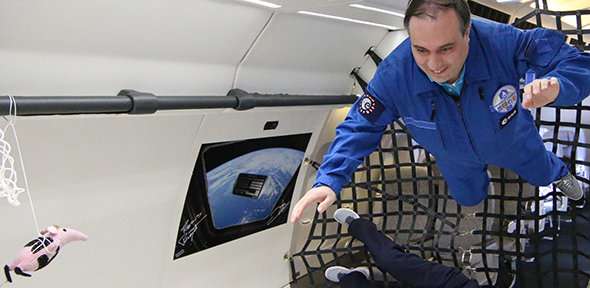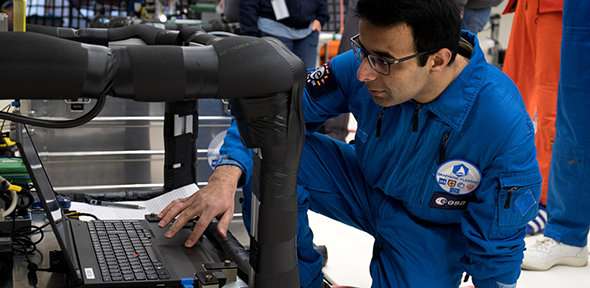Zero gravity graphene promises success in space

In a series of exciting experiments, Cambridge researchers experienced weightlessness testing graphene's application in space.
Working as part of a collaboration between the Graphene Flagship and the European Space Agency, researchers from the Cambridge Graphene Centre have tested graphene in microgravity conditions for the first time.
Testing graphene's potential in cooling systems for satellites, the researchers experienced weightlessness inside a parabolic flight – also known as the 'vomit comet'.
"Graphene as we know has a lot of opportunities. One of them, recognised early on, is space applications, and this is the first time that graphene has been tested in space-like applications, worldwide," said Professor Andrea Ferrari, Director of the Cambridge Graphene Centre.
Professor Ferrari is also Science and Technology Officer and Chair of the Management Panel for the Graphene Flagship.
Graphene – the single-atom thick allotrope of carbon – has a unique combination of properties that make it interesting for applications from flexible electronics and fast data communication, to enhanced structural materials and water treatments. It is highly electrically and thermally conductive, as well as strong and flexible.
In this experiment, conducted in November and December last year, the researchers aimed to improve the performance of cooling systems in use in satellites, making use of graphene's excellent thermal properties.
"We are using graphene in what are called loop-heat pipes. These are pumps that move fluid without the need for any mechanical parts, so there is no wear and tear, which is very important for space applications," said Professor Ferrari.
"We are aiming at an increased lifetime and an improved autonomy of the satellites and space probes. By adding graphene, we will have a more reliable loop heat pipe, capable to operate autonomously in space," added Dr. Marco Molina. Dr. Molina is Chief Technical Officer of the Space line of business at Leonardo, an industry partner of the experiment.
In a loop-heat pipe, evaporation and condensation of a fluid is used to transport heat from hot electronic systems out into space. The pressure of the evaporation-condensation cycle forces fluid through the closed systems, providing continuous cooling.
The main element of the loop-heat pipe is the metallic wick, where the fluid is evaporated into gas. In these experiments, the metallic wick was coated in graphene providing two benefits improving efficiency of the heat pipe. Firstly, graphene's excellent thermal properties improve the heat transfer from the hot systems into the wick. Secondly, the porous structure of the graphene coating increases the interaction of the wick with the fluid, and improves the capillary pressure, meaning the liquid can flow through the wick faster.

After excellent results in laboratory tests, the graphene-coated wicks were tested in space-like conditions on board a Zero-G parabolic flight. To create weightlessness, the plane undergoes a series of parabolic manoeuvres, creating up to 23 seconds of weightlessness in each manoeuvre.
"It was truly a wonderful experience to feel weightlessness, but also the hyper-gravity moments in the plane. I was very excited but at the same time a bit nervous. I couldn't sleep the night before," said Dr. Yarjan Samad, a Research Associate in the Cambridge Graphene Centre.
In the flight, the graphene-coated wicks again demonstrate excellent performance, with more efficient heat and fluid transfer compared to the untreated wicks. Based on these promising results, the researchers are continuing to develop and optimise the coatings for applications in real space conditions.
"The next step will be to start working on a prototype that could go either on a satellite or on the space station," said Professor Ferrari.
Provided by University of Cambridge



















